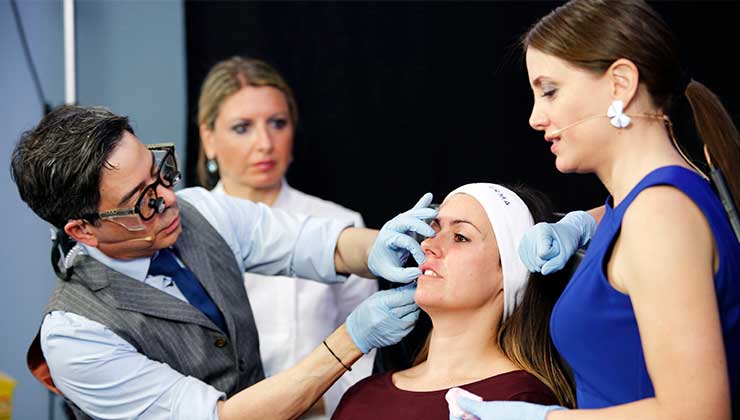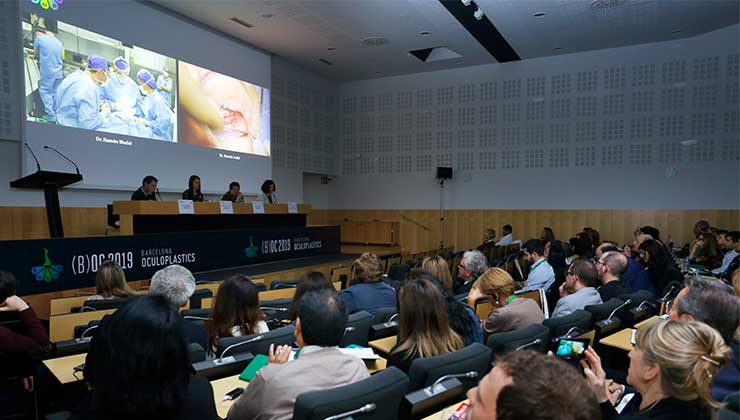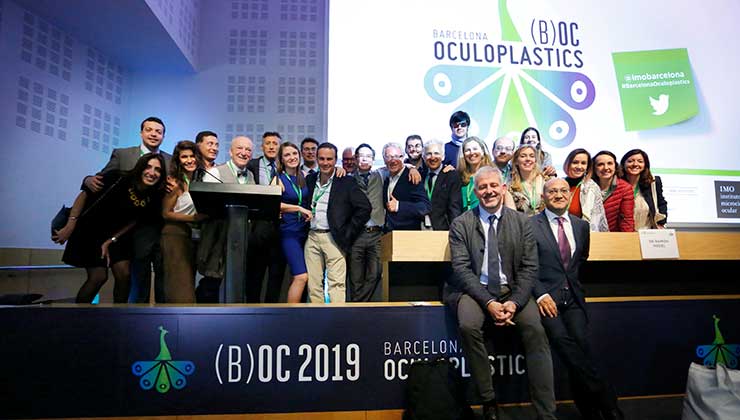Nearly 400 specialists from around forty countries have gathered at IMO during the fourth edition of Barcelona Oculoplastics, a course organized by the IMO Foundation, which presented the latest trends in the aesthetic and functional approach to the upper face. During the course, it has been noted the rise in demand for aesthetic medicine, especially non-surgical treatments in the oculofacial field, as well as the minimally invasive approach of both these therapies and other surgical procedures, such as the frontal flap or endoscopic surgery, a technique that attendees have been able to see live through the revolutionary 3D eye surgery.
The rise of aesthetics in the Selfie era
In the 2019 edition, the focus has been on the boom in aesthetics, a field that has not stopped growing in recent years and that has more and more alternatives without the need to go through the operating room. “Patients demand simple treatments that do not require leaves or prevent them from leading normal lives. In addition, they want to look better, without denying their age but looking for natural results”, explains Dr. Luz Maria Vasquez, a specialist in the Departments of Oculoplastics and Aesthetics and Oculofacial Rejuvenation at IMO and co-organizer of the meeting. Experts have offered live demonstrations of these non-surgical methods, such as Ultherapy, which provides a lifting effect, or the injection of filling substances, such as hyaluronic acid, and botulinum toxin (botox), highlighting their effectiveness and safety.
For Dr. José Raúl Montes, a renowned specialist in injectable medicine and facial remodelling, the role of specialists in this boom in aesthetics is crucial. “We live in the era of the selfie, in which people want to look better on their social networks. But sometimes less is more; we professionals must carefully look at the anatomical structures of the patient and decide what he really needs to achieve more harmony, symmetry and freshness in his face in a safe way”, explains the expert. According to Montes, in these types of procedures, “it is advisable to monitor the depth of the injections, which may be superficial or deep, but never intermediate, to avoid possible complications, such as necrosis and loss of vision, as well as a plunger in the central artery of the retina or other arteries”.

In the “age of the Selfie”, the ophthalmologists specialized in oculofacial aesthetics alert at IMO about the importance of being conservative, preserving the anatomical features and prioritizing safety and naturalness.
The tendency to improve the appearance of the face in the consulting room instead of in the operating room is also recognized by other experts in conventional surgery who participated in the congress, such as the English oculoplastic surgeon Dr. Naresh Joshi, who admits that “most patients want fewer and fewer surgeries, so new non-surgical therapies are increasingly popular. I think that in the future they will become even more important in the future."
Surgical advances
Despite the increase of in-office therapies, facial aesthetic surgery continues to be the solution for a certain group of patients and also continues to be perfected with techniques that tend to be minimally invasive. During the live surgeries at Barcelona Oculoplastics 2019, which opened the course, attendees were able to see different surgical approaches to treat palpebral pathologies, such as ptosis (drooping eyelids). One of the most cutting-edge techniques is the direct frontal flap, which was developed by IMO specialists and which, for yet another edition, has become one of the star procedures of the event: “Everyone wants to do it because it has many advantages over other techniques; many surgeons want to come and see how we do the small details of the surgery to start doing it in their centers”, explains Dr. Ramón Medel, a specialist from the IMO Departments of Oculoplastics and Aesthetics and Oculofacial Rejuvenation and co-organizer of the meeting.

The trend towards minimally invasive interventions was highlighted in the live surgery session, one of the strengths of Barcelona Oculoplastics 2019, along with a pioneering commitment to 3D technology.
Another of the leading procedures discussed at the meeting is endoscopic surgery, which makes it possible to treat diseases of the tear ducts and the orbit without leaving any visible incision, with very rapid recovery and very detailed visibility of the anatomy. Specifically, a novel demonstration of orbital decompression has been made, a technique that is performed to treat exophthalmos (or bulging eyes). “We have performed, for the first time in the world, an endoscopic anatomical dissection in a cadaver head that has been able to be followed with 3D technology. It's a technique that takes time, a long learning process, but I think it's the present and future for treating many diseases”, says Dr. Eduardo Rubin, an Argentine ophthalmologist who participated in the congress and has more than 20 years of experience in this type of procedure. This new route of entry through the nostrils, seen in a pioneering way at Barcelona Oculoplastics 2019, will allow specialists to get closer in a different way to the patient who needs functional surgery in the upper face. “It has been an impressive anatomy class that opens a door to treat orbital pathologies from another point of view”, concludes Dr. Ramon Medel.
Don't miss the video summary of the meeting below!
